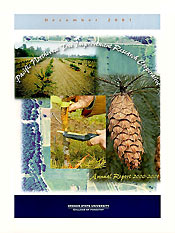Annual Report 2000-01
Highlights of 2000-2001
- Glenn Howe agreed to become Director of PNWTIRC and Assistant Professor of forest genetics in the Department of Forest Science.
- Gancho Slavov arrived in September of 2000 to begin a Ph.D. program with PNWTIRC. He will work on the Pollen Contamination Study.
- Nine journal articles and abstracts were completed by PNWTIRC staff (i.e., published or in press).
- Flower stimulation treatments were applied in the Early Flowering Study. Gibberellic acid and girdling treatments were applied to 2- and 4-year-old grafts in the Vaughn and NWCTGA orchards. This study is designed to (1) develop improved methods for promoting early and sustained flowering on young Douglas-fir grafts, (2) determine the optimum age to begin flower stimulation treatments and (3) measure the impacts of early flower stimulation on ramet health. The best treatments will be used in the Miniaturized Seed Orchard Study.
- Three orchard types (macro, mini and micro), two supplemental blocks (mini and micro) and one holding block were established in the Miniaturized Seed Orchard Study. We planted the rootstock, installed the irrigation system and applied nitrogen fertilizer. The scions will be grafted onto the rootstock in February 2002.
- We developed 15 new promising SSR markers in the Pollen Contamination Study. These markers were derived from five new SSR libraries that were constructed using recently improved molecular techniques. At least 62 potentially promising SSR markers remain to be tested.
- We completed the analyses of bud phenology, second flushing and cold hardiness for 39 full-sib families of Douglas-fir in the Seedling Drought Physiology Study. Although very mild drought often enhances cold hardiness under routine nursery conditions, severe drought reduced the cold hardiness of 2-year-old seedlings in our study. There was a tendency for cold damage to be increased in families that set bud late in the fall, second flushed and grew taller. Family rankings for bud phenology, second flushing and cold hardiness were similar in the different moisture regimes. In addition, drought hardiness traits, such as drought-induced foliage damage, xylem cavitation and hydraulic conductivity were unrelated to bud set, second flushing and cold hardiness. Both of these observations suggest that selection and breeding for improved bud phenology and cold hardiness is unlikely to affect drought hardiness.


